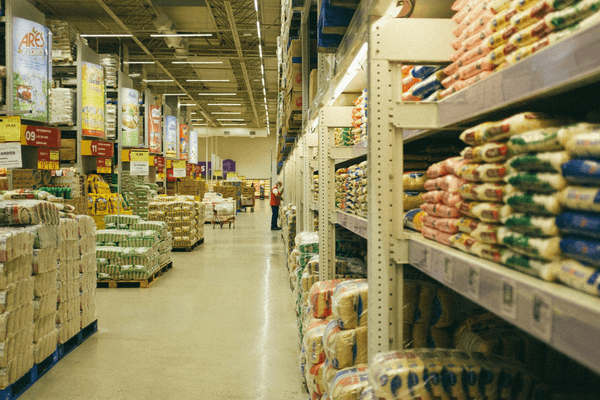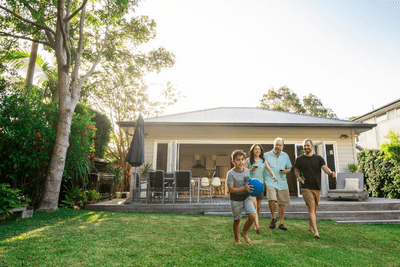
Share
Large format retail properties deliver 6.5% yields, outperforming other commercial assets. Discover why LFR investments benefit from Australia's population boom.
While most investors chase the latest property trends or debate office versus industrial investments, a quietly powerful sector has been delivering superior returns right under their noses. Large format retail properties — those sprawling warehouse-style stores where you buy everything from power tools to dining tables — have consistently outperformed the broader commercial property market.
With average yields of 6.5% crushing other commercial property classes and backed by Australia’s population boom, large format retail (LFR) offers something increasingly rare in today’s market: genuine value combined with defensive characteristics. If you’re looking for an investment that makes sense both on paper and in practice, it’s time to take a closer look at this overlooked opportunity.
What exactly is large format retail
Think of large format retail as the practical cousin of traditional shopping centres. These are those massive warehouse-style buildings ranging from 1,000 to 10,000 square metres that house the stores you probably visit more often than you realise.
You know these places well, even if you’ve never thought of them as investments. That weekend trip to Bunnings for garden supplies? Large format retail. Shopping for a new mattress at Harvey Norman? LFR again. Picking up office supplies at Officeworks or browsing furniture at Amart? All large format retail.
The practical difference
Unlike shopping centres with their enclosed malls, food courts, and complex tenant mixes, LFR properties focus on function over form. Picture individual warehouse stores arranged around shared parking areas — it’s retail stripped back to basics, but that simplicity is exactly what makes it work so well.
These buildings prioritise what matters most: accessibility, storage space, and operational efficiency. There’s no expensive marble flooring or elaborate decorative features. Instead, you get high ceilings, wide aisles, and plenty of parking — exactly what you need when buying a washing machine or a week’s worth of hardware supplies.
This no-frills approach isn’t just practical for shoppers; it’s brilliant for investors. Lower construction costs mean higher initial yields, while the straightforward design attracts quality tenants seeking cost-effective retail space.
Why the yields make investors pay attention
Here’s where LFR gets really interesting for your investment portfolio. In 2024, these properties delivered average yields of 6.5% — significantly ahead of CBD offices at 6%, regional shopping centres at 5.5%, and industrial warehouses at 5.4%.
But this isn’t just a one-year wonder. Over the past decade, LFR has averaged 7.46% yields compared to industrial properties at 5.84% and neighbourhood shopping centres at 6.14%. That’s a meaningful difference that compounds significantly over time.
Why these yields stay strong
The secret lies in the tenants themselves. When Bunnings signs a lease, they’re not planning to move anytime soon. These retailers invest heavily in store fit-outs, build customer loyalty in specific locations, and operate on long-term business strategies. This creates what investors love most: predictable, stable income streams.
Plus, many LFR products fall into the “needs, not wants” category. You might delay buying a new car or holiday, but when your washing machine breaks or you need supplies for urgent home repairs, those purchases can’t wait. This defensive characteristic helps protect rental income even when economic conditions tighten.
In today’s higher interest rate environment, finding genuine 6%+ yields from quality assets with established tenants represents genuine value that’s increasingly hard to find elsewhere.
Australia’s population boom creates perfect conditions
Here’s where the LFR investment story gets compelling. Australia is experiencing one of the fastest population growth rates in the developed world, with over 15% growth expected between 2023 and 2033. That translates to 4.43 million new residents who all need somewhere to live and furnish their homes.
The furniture and appliance connection
Think about what happens when people move house or set up new homes. They need furniture, appliances, hardware supplies, and household goods — exactly what LFR retailers sell. Every new migrant family represents multiple shopping trips to Harvey Norman, Bunnings, and similar stores over their first few years in Australia.
The numbers are staggering: experts project an additional $45 billion in retail spending from migration-related demand over the next decade. That’s $4.5 billion annually flowing through the exact types of stores that anchor LFR properties.
Supply isn’t keeping up
Here’s the kicker: while Australia’s population has grown 15% over the past decade, retail space per person has actually declined from 2.3 square metres per person to under 2.1 square metres. We’re literally running out of retail space relative to population growth.
New LFR supply remains severely constrained. There’s only 711,845 square metres of new space planned through 2026 — that’s just 0.41 square metres per additional resident. Compare that to current levels, and you can see why existing LFR properties are becoming increasingly valuable.
Land suitable for LFR development has become scarce, particularly in metropolitan areas where demand is strongest. Planning restrictions and competition from industrial users further limit new supply, creating scarcity value for existing properties.
Investment market shows interesting trends
The LFR investment market tells a fascinating story of changing investor behaviour and emerging opportunities. Transaction volumes peaked at $3.7 billion in 2022 before cooling to around $810 million in 2024. However, early 2025 activity suggests the market is finding its feet again.
Private investors step up
One of the most significant trends has been the shift toward private investment. In 2023, private buyers represented 66% of transactions, more than doubling from just 36% in 2020. This suggests institutional investors may have stepped back, creating opportunities for sophisticated private investors to acquire quality assets.
The market has also developed what experts call a “flight to quality” mentality. Investors increasingly focus on premium assets with strong anchor tenants, strategic locations, and modern facilities. These top-tier properties have become tightly held, with owners recognising their long-term value and reluctant to sell.
Scarcity creates value
With only 332 LFR centres operating nationally across 5.345 million square metres of space, this represents one of the most tightly held commercial property sectors. When quality assets do come to market, they attract strong interest and command premium pricing.
This scarcity dynamic works in favour of existing property owners, supporting both rental growth and capital values over time.
Construction advantages that boost returns
LFR properties offer practical advantages that directly impact your investment returns. These buildings cost significantly less to construct per square metre compared to traditional shopping centres, thanks to their simplified warehouse design and standardised construction methods.
Faster to build, quicker returns
Development timeframes prove substantially shorter than complex retail projects. There’s no need for elaborate architectural features, complex internal layouts, or sophisticated common area systems. This means faster approvals, simpler construction, and quicker tenant occupancy — all of which improve investment returns.
The operational benefits continue after construction. LFR properties typically require lower ongoing maintenance costs due to their robust warehouse construction and simplified building systems. Tenants often handle their own internal fit-outs and maintenance, reducing landlord responsibilities and expenses.
The omnichannel advantage
Modern LFR developments increasingly serve dual purposes as both retail showrooms and distribution centres. Retailers can combine customer-facing space with logistics operations, reducing their overall property costs while improving online delivery capabilities.
This integrated approach provides competitive advantages that help retain tenants and support rental growth. As online shopping continues growing, the ability to offer efficient click-and-collect and last-mile delivery services becomes increasingly valuable for retailers.
Regional opportunities vary significantly
LFR investment prospects differ markedly across Australian markets, creating opportunities for investors to match their strategies with specific regional characteristics.
Adelaide leads rental growth expectations at 3.8%, reflecting strong interstate migration attracted by the city’s relative affordability. Melbourne follows at 3.6%, supported by continued international migration and ongoing development. Sydney is projected to rebound with 2.6% growth after experiencing declines in 2023, suggesting market stabilisation.
Metropolitan versus regional play
Brisbane and Perth offer healthy growth prospects at 2.5% and 2.1% respectively, while providing more affordable entry points than Sydney or Melbourne. These markets benefit from ongoing population growth and economic development while offering higher initial yields.
Regional centres increasingly attract investor attention as major retailers expand beyond capital cities. Regional locations often provide higher yields and benefit from retailer strategies targeting growing regional populations. However, they may offer less liquidity and require more careful tenant and location analysis.
Supply constraints prove most severe in major metropolitan areas, particularly Sydney and Melbourne, where land scarcity creates additional value support for existing assets.
Spotlight on key tenants
The investment appeal of LFR properties largely depends on tenant quality, and several major retailers provide the stable foundation that makes these investments work.
Bunnings leads the pack
Bunnings operates 282 large warehouse stores generating $17.8 billion annually, making it Australia’s undisputed hardware retail leader. The company’s market dominance stems from competitive pricing, comprehensive product ranges, and strong community connections built through weekend sausage sizzles and DIY workshops.
Bunnings’ expansion plans include growing their commercial business and expanding frame and truss operations, demonstrating ongoing commitment to their large-format retail model. For property investors, Bunnings represents the gold standard of LFR tenants — stable, profitable, and focused on long-term growth.
Harvey Norman’s property focus
Harvey Norman offers a unique tenant profile through its integrated retail and property model. The company owns a $4.14 billion real estate portfolio that generates substantial returns while supporting retail operations. This property-focused approach means Harvey Norman understands the value of good locations and tends to be a stable, long-term tenant.
The retailer’s global expansion strategy, including recent UK market entry, reflects management confidence in the large-format retail model while diversifying their revenue base.
Emerging lifestyle categories
The sector is evolving beyond traditional bulky goods retailers. “Lifestyle” category tenants like Chemist Warehouse and Autobarn represent a shift toward more frequent-visit retailers that complement traditional furniture and hardware stores.
This diversification reduces investment risk while expanding potential customer bases. Lifestyle retailers typically generate more frequent visits than traditional furniture purchases, potentially supporting higher foot traffic and improved centre performance.
Investment approaches for different situations
LFR properties accommodate various investment strategies, allowing you to participate according to your available capital, risk tolerance, and involvement preferences.
Getting started
Entry-level opportunities often centre around single-tenant properties featuring established retailers. A Bunnings or Harvey Norman store with a long-term lease provides straightforward investment propositions with clear income streams and minimal management requirements. These properties typically offer higher yields than multi-tenant alternatives while providing exposure to proven retail concepts.
Building a portfolio
More sophisticated investors often combine LFR assets with other commercial property types to achieve portfolio diversification. The sector’s superior yield characteristics help balance lower-yielding assets while providing defensive characteristics during economic uncertainty.
Geographic diversification across different Australian markets allows investors to benefit from varying economic cycles and growth patterns. What works in Adelaide may differ from opportunities in Perth, creating scope for tailored investment strategies.
Professional management options
For investors seeking LFR exposure without direct property ownership responsibilities, specialist funds provide access to diversified portfolios with professional management. These vehicles offer economies of scale and expertise while allowing smaller investors to participate in institutional-quality assets.
The key is matching your investment approach to your personal circumstances, including available capital, desired involvement level, tax position, and overall portfolio objectives.
Risks you need to understand
While LFR properties offer compelling opportunities, several risks require careful evaluation before committing significant capital.
Interest rate sensitivity affects all property investments, but LFR assets face particular exposure due to their yield-focused investor base. Rising rates can compress valuations and reduce investor demand, impacting both capital values and transaction activity.
The online retail question
Competition from online shopping continues reshaping retail, though LFR categories prove more resilient than many others. Products requiring demonstration, comparison shopping, or immediate need (like emergency hardware supplies) resist online disruption better than standardised goods.
However, ongoing digital innovation could impact tenant performance over time. The most successful LFR retailers are adapting by integrating online and physical operations, using their stores as distribution centres while maintaining traditional retail functions.
Economic cycle impacts
Economic downturns affect discretionary spending on furniture, electronics, and home improvement products. While many LFR goods represent needs rather than wants, prolonged economic weakness could pressure tenant sales and rental affordability.
Single-tenant properties face concentration risk if major tenants encounter difficulties or choose to downsize. The specialised nature of LFR buildings can make re-tenanting challenging, particularly for very large spaces designed around specific retail concepts.
Due diligence remains crucial
Successful LFR investment requires thorough analysis of tenant quality, lease terms, location characteristics, and local market fundamentals. Professional property advice and ongoing market monitoring help identify and manage risks while maximising opportunities.
What the future holds
Several emerging trends suggest LFR properties are well-positioned for continued growth over the coming decade.
Technology integration is transforming how retailers operate, with many implementing omnichannel strategies that blend physical stores with online sales and distribution. Modern LFR properties increasingly serve dual functions as retail destinations and logistics hubs, creating efficiency gains that support tenant profitability and rental sustainability.
Sustainability becomes important
Environmental, social, and governance (ESG) measures are becoming increasingly important for both tenants and investors. LFR properties offer excellent opportunities for solar installations, energy-efficient systems, and sustainable construction that can reduce operating costs while meeting corporate sustainability targets.
The sector’s evolution toward lifestyle retailers and experiential offerings suggests LFR centres may become more community-focused destinations rather than purely transactional retail environments. This transformation could support higher rental rates and improved tenant retention.
Demographics support growth
Long-term demographic trends strongly favour continued LFR demand. Australia’s aging population will drive demand for home modification and healthcare products. Growing environmental consciousness supports renewable energy equipment and sustainable home products. Continued urbanisation creates demand for efficient retail formats serving dense populations.
Supply constraints are likely to persist given ongoing land scarcity and planning restrictions in major metropolitan areas, supporting asset values and rental growth for well-located existing properties.
The investment case in summary
Large format retail has quietly established itself as one of Australia’s most compelling commercial property investment opportunities. The combination of superior yields averaging 6.5%, stable income from established tenants, and powerful demographic drivers creates an attractive proposition that outperforms many alternatives.
Australia’s exceptional population growth, adding 4.43 million residents by 2033, provides fundamental demand support that underpins long-term sector prospects. The growing imbalance between population expansion and retail space development creates scarcity value that should support both rental growth and capital appreciation.
Why now makes sense
The sector’s construction efficiencies, operational advantages, and evolution toward omnichannel functionality position LFR properties to benefit from rather than be disrupted by changing retail patterns. Quality assets have become increasingly tightly held, reflecting sophisticated investor recognition of their long-term value.
While risks around interest rates, economic cycles, and retail evolution require careful management, LFR’s defensive characteristics and focus on necessary products provide stability that many other commercial property types lack.
For investors seeking to diversify portfolios with high-quality commercial property delivering sustainable income returns, large format retail deserves serious evaluation. The sector accommodates various investment approaches while offering both current income and future growth potential.
As with any substantial investment decision, professional advice and thorough due diligence remain important to identify the best opportunities and structure investments appropriately for your individual circumstances. But for those willing to look beyond traditional property sectors, LFR offers a compelling combination of income, growth, and defensive characteristics that’s increasingly rare in today’s market.
Further questions
What is large format retail and how does it differ from shopping centres?
Why do large format retail properties offer higher yields than other commercial property types?
How does Australia's population growth support large format retail investment opportunities?
What are the main risks involved in investing in large format retail properties?
Which cities offer the best large format retail investment opportunities in Australia?
This is general information only and is subject to change at any given time. Your complete financial situation will need to be assessed before acceptance of any proposal or product.





